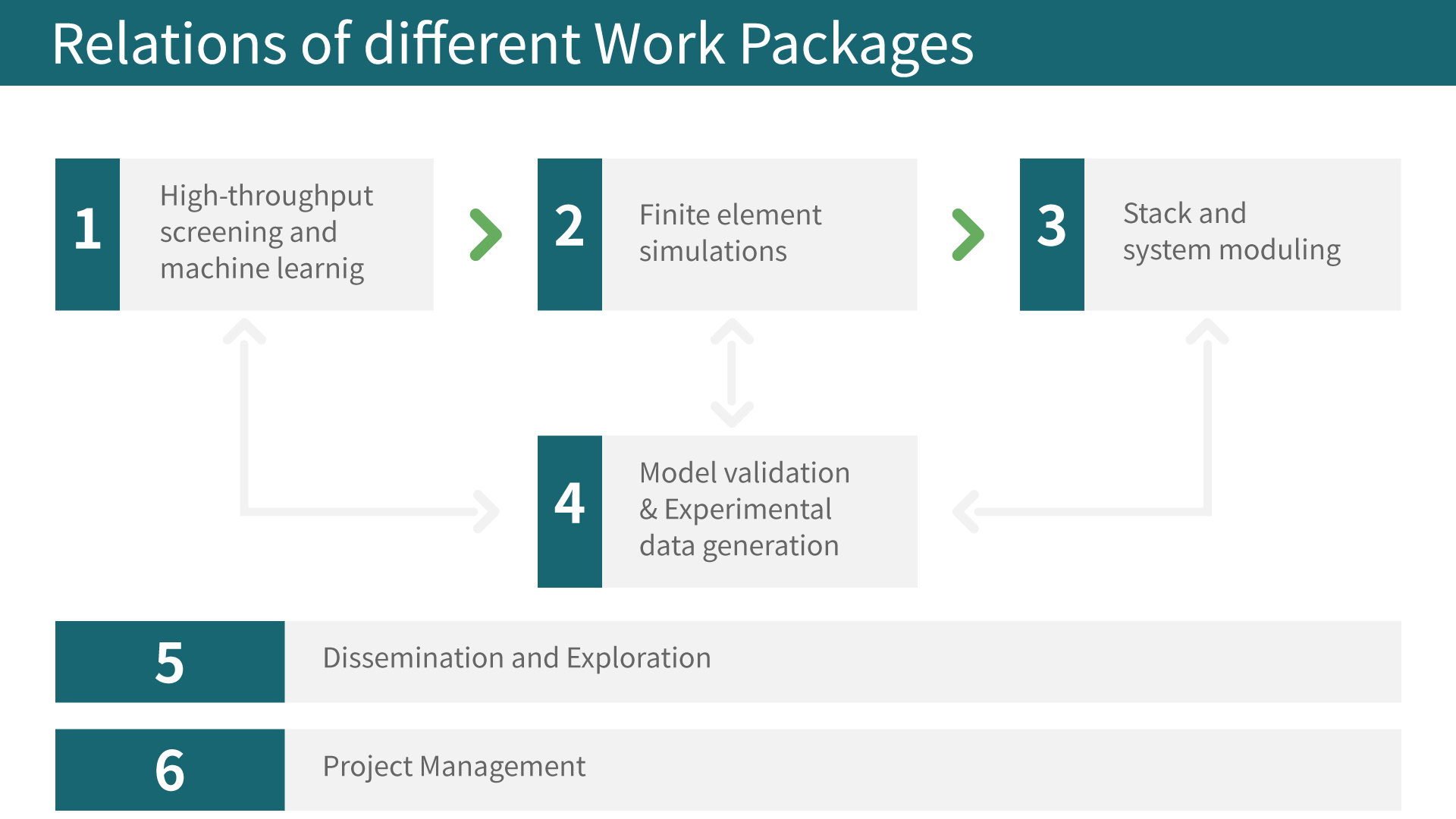What we do
What we do
What we do
Electrical energy storage is one of the key challenges to address to realize the green transition to a low-carbon economy. An extensive storage capacity will be required to balance the fluctuating nature of variable renewable energy sources such as wind and solar.
Redox Flow Batteries (RFBs) are a promising option for large scale stationary energy storage. RFBs utilize redox active materials dissolved in liquid electrolytes stored in tanks, and the amount of the stored energy depends on the volume of the tanks. Pumps ensure the circulation of the electrolytes through electrochemical cells where the electrochemical reactions take place.
RFBs have a great potential for stationary applications, due to a set of features such as the possibility to decouple energy (tank size and amount of electrolyte) and power (cell surface and pumped mass flow) thanks to their modular nature which makes them extremely flexible and scalable in design. In addition, it is possible to fully recover performance losses with time and number of cycles, up to nominal conditions with moderate maintenance. Finally, the lifecycle that they can reach is long, above 10000 cycles which may easily mean ten to twenty years thanks to the already reached stability of the redox active materials.
State-of-the-art of RFBs work with non-flammable aqueous electrolytes utilizing highly acidic solutions based on vanadium sulfates. On the one hand, vanadium is recyclable and not scarcely present on earth as lithium, therefore if properly recycled it would lead to a lower environmental footprint. On the other hand, it would be better to develop the RFBs working with non-corrosive solutions and based on ubiquitous materials such as organic molecules or non-toxic metals. This could boost a large scale deployment because it would dramatically reduce its price and environmental impact, plus reduce the dependence of European Union from importing vanadium.
Affordable RFBs based on renewable or abundant raw materials are therefore urgently needed. The potential energy storage materials are chemicals that need to fulfil several criteria, including a reasonable high energy density, stability, and production at an affordable cost, but no such chemicals have been discovered yet. To contribute towards solving this problem, CompBat will focus on developing tools for the discovery of new prospective candidates for next-generation flow batteries, based on machine learning assisted high-throughput screening. Density functional theory calculations will be used to obtain data on solubilities and redox potentials of different molecules, and machine learning methods are used to develop high-throughput screening tools based on the obtained data. The results of the high-throughput screening are validated with experimental results. Target molecules will be bio-inspired organic compounds, as well as derivatives of the redox active chemical species already manufactured in bulk quantities. We propose to use safe and inexpensive natural products, such as vitamins and amino acids as building blocks for aqueous flow battery materials operating close to neutral pH. The advantages of natural product derived materials include: 1) scalable production in tanks by fermentation with reasonable cost, 2) inherent safety and expected biodegradability due to their biological origin and natural roles even in the human body, 3) solubility in water, and 4) high degree of functionalization, minimizing the need for synthetic steps to modify them.
As next step, numerical modelling of flow battery systems will be performed with finite element method enabling to investigate cell details and provide the required information to develop more general zero-dimensional models based on mass-transfer coefficients. The latter would enable faster and reliable simulations of the cells performance that could be verified with the first ones. Both models will also be validated experimentally and used for generating a data-set to allow prediction of the flow battery cell performance based on properties of the prospective candidates obtained from high throughput screening.
Finally, cells will be piled in stacks reaching higher power values and modelled to understand the effect of parasitic shunt currents, as well as including the effect of other components as pumps and tanks. Furthermore, the battery performance will be enhanced by the use of solid boosters, to be manufactured from inexpensive and abundant raw materials. Solid boosters consist of particles introduced into the flow battery solution tanks as beads composed only of the active material, conductive additive and binder. Due to the reaction between the solid particles and the active components present in the electrolyte, the dissolved redox species, the storage capacity will be enhanced only at the extra cost of the raw materials. In fact, the amount of electrolyte will be the same, and the limiting factor to the capacity will no longer be the solubility of the dissolved species determining a higher energy density than that of the conventional RFBs.
This data is used then to predict the flow battery overall system performance. In this way, including economic assumptions will be possible to develop tools capable of assessing the battery costs and stored energy cost, such as the Levelized Cost Of Storage (LCOS). So techno-economic studies could be performed, comparing different solutions in terms of storage technology and energy system integration, as well as identifying suitable targets for the RFBs development.
The CompBat action is divided into 3 modelling and one experimental Work Packages, and there are also WPs devoted to Dissemination and exploitation, as well as to Project management.
WP1 focuses on development of high-throughput screening methods for discovery of new prospective flow battery candidates. WP2 will develop different cell level models based on finite element simulations, and WP3 will cover zero-dimensional modelling for both single cell and stack level, as well as techno-economic assessment to evaluate the cost. WP4 will generate experimental data for validation of the models developed in WPs 1-3, and will also test new redox couples proposed by WP1.
Here below you can find how the above mentioned activities are distributed among the partners, where the contribution of each of the project partners and the flow of information among them are reported:
